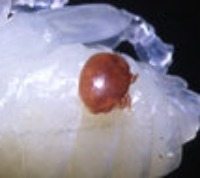Varroa Destructor Resistant Honey Bees - The 'Mite-Biter' Honey Bees
Updated: 28th January 2021
Given that behavior traits in honey bees are genetic, it therefore follows that breeding programs can be devised to ensure the breeding of more honey bees with 'desirable' behaviors.
Much work has been ongoing to breed honey bees with behaviors that would help counteract the dreaded Varroa destructor mite.
How behavioral traits of the 'Indiana mite-biter bees' may help Apis mellifera defeat the deadly Varroa destructor mite
Grooming and 'hygienic' behavior are considered important natural defenses for honey bees in dealing with Varroa mite. Behaviors already recognized to increase Varroa destructor resistance in honey bee colonies, include:
 Varroa mite on a honey bee larva
Varroa mite on a honey bee larva- grooming behavior and removal of mites from the bees’ bodies; and
- the Varroa sensitive hygiene (VSH) trait, which describes the ability of bees to detect and remove infested brood where V. destructor reproduces.
Mite-biting honey bees
One of the most remarkable developments I have seen over the last few years, is the 'mite-biter honey bees'. The mite-biting trait is potentially a further arsenal honey bees could use in their natural defenses against Varroa.
Watch below as a 'mite-biter' honey bee wastes no time as it bites and removes a mite introduced by the scientist:
In 2011, Andino and Hunt (ref 1) reported that the proportion of damaged mites (presumably chewed by worker bees and that fell onto sampling sheets) was a good indicator of grooming behavior.
In a program carried out at Purdue University (Hunt et al. 2016 - ref 2) researchers worked with beekeepers from USA Midwest states. They used this 'mite biting' colony trait in a breeding program to select for increased Varroa destructor resistance.
A study published December 2019 in Apidologie (ref 3), provides evidence that honey bees selected for mite-biting behavior have reduced Varroa destructor infestations. Indeed, the scientists conclude that:
"selection for mite-biting behavior reduces V. destructor infestations, increases colony survival and increases the expression of a grooming behavior–associated gene".
In tandem with overall colony survival, scientists found that in colonies where honey bees have the mite-biter traits:
- the proportion of mutilated mites, the severity of mutilations, and winter colony survival were higher (winter colony survival rate was actually 3 times higher than with the Italian honey bee colony).
- the rate of mite population growth was lower.
For me, natural defenses such as this are preferable to chemical treatments being introduced into the hive. Let's hope these traits will be found in more colonies soon, and that general honey bee health will be greatly improved as a result.
References
1. Andino, G.K., Hunt, G.J. (2011). A scientific note on a new assay to measure honeybee mite-grooming behavior. Apidologie, 42(4), 481-484.
2. Hunt, G., Given, J.K., Tsuruda, J.M., Andino, G.K. (2016). Breeding mite-biting bees to control Varroa. Bee Cult., 8, 41-47.
3. Morfin, N., Given, K., Evans, M. et al. Grooming behavior and gene expression of the Indiana “mite-biter” honey bee stock. Apidologie 51, 267–275 (2020). https://doi.org/10.1007/s13592-019-00710-y